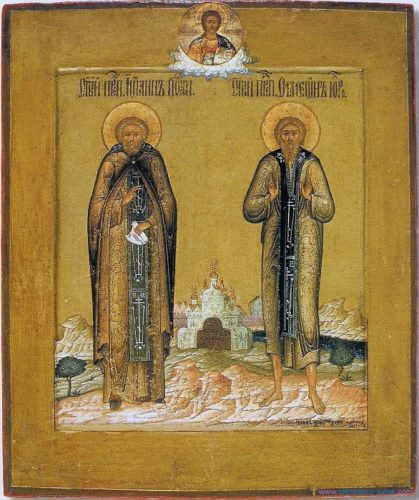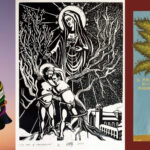Last Updated on July 20, 2024 by Kittredge Cherry
Sixth-century Syrian monks Symeon and John were joined in a same-sex union and lived together as desert-dwelling hermits for 29 years. After a tearful split-up, Symeon went on to become known as the Holy Fool of Emesa, the patron saint of all holy fools (and puppeteers.) Their feast day is July 21.
These Byzantine saints are important for LGBTQ people because of their loving same-sex bond and Symeon’s role as holy fool. In the tradition of “fools for Christ,” believers deliberately challenge social norms for spiritual purposes. LGBTQ Christians, who face insults from both sides for being queer AND Christian, may be able to relate to the motivations and experiences of the holy fools. Another queer holy fool is Xenia / Andrei of St. Petersburg, a widow who adopted her husband’s identity and spent 45 years living free of worldly possessions as an ascetic “fool for Christ” in 18th century Russia.
Symeon the Holy Fool (or Simeon Salus) of Emesa (c. 522 – c.588) and John of Edessa were close friends starting in childhood, although Symeon was six years older. Both came from wealthy families. When Symeon was 30, they made a pilgrimage to Jerusalem. On the journey home they were both filled with an irresistible desire to leave their families and join a monastery together.
They took vows in the monastery of Abba Gerasimus in Syria. The two men were tonsured by the abbot who blessed them together in an early monastic version of the adelphopoiesis ceremony — the “brother-making” ritual that historian John Boswell calls a “same-sex union.” They were referred to as the “pure bridegrooms (nymphoi) of Christ.”
 Scholar Claudia Rapp writes about Symeon and John as “the original context for the practice of blessing a bond between two men, making them ‘brothers’” in her 2016 book “Brother-Making in Late Antiquity and Byzantium: Monks, Laymen, and Christian Ritual.” She discusses their relationship in a detailed case study.
Scholar Claudia Rapp writes about Symeon and John as “the original context for the practice of blessing a bond between two men, making them ‘brothers’” in her 2016 book “Brother-Making in Late Antiquity and Byzantium: Monks, Laymen, and Christian Ritual.” She discusses their relationship in a detailed case study.

“Symeon the Holy Fool and his friend John,” Eastern Orthodox icon (Wikipedia)
Soon after being joined in a same-sex union, the two men went together to live as hermits in the desert near the Dead Sea, where they could practice spiritual exercises in solitude. There is no suggestion that their relationship was sexual, but they shared a life together in the wilderness with all the emotional intensity of a same-sex couple for 29 years.
At that point Symeon decided to leave his longtime companion and move to the city of Emesa in modern Lebanon. He wanted to do charity work while mocking social norms as a “fool for Christ.” John begged him not to go. John’s passionate plea is recorded in “Symeon the Holy Fool” by Derek Krueger:
“Please, for the Lord’s sake, do not leave wretched me. For I have not yet reached this level, so that I can mock the world. Rather for the sake of Him who joined us, do not wish to be parted from your brother. You know that, after God, I have no one except you, my brother, but I renounced all and was bound to you, and now you wish to leave me in the desert, as in an open sea. Remember that day when we drew lots and went down to lord Nikon, that we agreed not to be separated from one another. Remember that fearful hour when we were clothed in the holy habit, and we two were as one soul, so that all were astonished at our love. Don’t forget the words of the great monk….Please don’t lest I die and God demands an account of my soul from you.”
Even this heartfelt appeal did not change Symeon’s mind. Instead he invited John into a long, intimate prayer session as described by Krueger:
“After they had prayed for many hours and had kissed each other on the breast and drenched them with their tears, John let go of Symeon and traveled together with him a long distance, for his soul would not let him be separated from him, but whenever Abba Symeon said to him ‘Turn back, brother,’ he heard the word as if a knife separated him from his body, and again he asked if he could accompany him a little further. Therefore, when Abba Symeon forced him, he turned back to his cell drenching the earth with tears.”
Symeon went on to help the poor, heal the sick and do other good works in Emesa. In order to avoid public praise, he shocked people by deliberately acting crazy, making himself a “holy fool.”
Not long before his death, Symeon had a vision in which he saw his beloved John wearing a crown with the inscription, “For endurance in the desert.”
Symeon and John were honored together as saints on July 21 in many ancient calendars. In the 16th century Caesar Baronius separated them and moved Symeon to July 1, but some traditions still celebrate them both on July 21.
Artist Jim Ru was inspired to paint the Symeon and John as a couple, with John’s fervent words to his beloved, “Please don’t leave lest I die and God demands an account of my soul from you.” The painting was displayed in his show “Transcendent Faith: Gay, Lesbian and Transgendered Saints” in Bisbee, Arizona in the 1990s.
The Byzantine dismissal hymn for the Feast of Symeon and John includes these lines:
Venerable John and divine Symeon,
united to God and united in soul to one another…
ever watch over us.
___
More resources:
“Brother-Making in Late Antiquity and Byzantium: Monks, Laymen, and Christian Ritual” reviewed by Kevin Elphick (Orthodoxy in Dialogue)
Simeon the Holy Fool (Wikipedia)
To read this post in Spanish / en español, go to Santos Queer:
Simeón de Emesa y Juan: un “santo loco” y un ermitaño que amaban el uno al otro
___
Top image credit:
“Symeon and John” by Jim Ru
____
This post is part of the LGBTQ Saints series by Kittredge Cherry. Traditional and alternative saints, people in the Bible, LGBTQ martyrs, authors, theologians, religious leaders, artists, deities and other figures of special interest to lesbian, gay, bisexual and transgender and queer (LGBTQ) people and our allies are covered.
This article was originally published in July 2017, expanded with new material over time, and most recently checked for accuracy on July 21, 2022.
Copyright © Kittredge Cherry. All rights reserved.
Qspirit.net presents the Jesus in Love Blog on LGBTQ spirituality.






















Even Alan Bray – a gay historian – finally decided that these “oaths of brotherhood” had nothing to do with same-sex marriage. He wrote an essay debunking this idea and John Boswell’s other ideas on the subject. This stuff has no historical credibility at all.
They only united in the soul, not in the body
God bless you for this important and God-inspired web site. +++